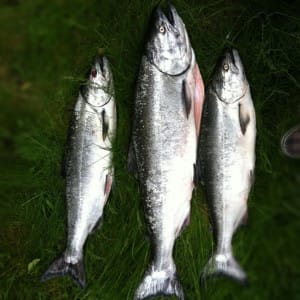Civil Eats
by Clare Leschin-Hoar
 |
Closing the fish oil gap
When Amanda West Reade was pregnant with her now two-year-old son, she started eating farmed salmon. As a vegetarian, she knew that getting enough protein, omega-3s, and folic acid to boost her growing baby’s development might be tricky.
“My doctor listed a few meal ideas and I thought I could handle the salmon,” says Reade. “She said to lean more towards farmed salmon because it was higher in omega-3s.”
Reade followed her doctor’s advice and added farmed salmon to her diet three times a week. “It became something I really craved,” she says.
Long-chain omega-3 fatty acids are good for the brain and eye development of growing babies and salmon has been a go-to meal for those looking for a reliable a low-mercury fish source. When it comes to omega-3 fatty acids, the message is the clear: All salmon is a good choice.
But that might soon change. A piece of farmed salmon today may contain as little as half the amount of omega-3s than it did a decade ago.
This is according to the International Fishmeal and Fish Oil Organization (IFFO), a trade group that represents stakeholders in the marine ingredient industry. The group is sounding the alarm over declining levels of omega-3s in farmed salmon.
“A 2008 paper showed that for every 3.5 ounces of farmed salmon you ate, you would get about 2-2.5 grams of EPA [eicosapentaenoic acid] and DHA [docosahexaenoic acid], and that was down from 3 grams three years earlier. Since 2008, it has come down further,” says Andrew Jackson, technical director at IFFO. “You’re probably only going to get 1.5 grams per serving now.”

